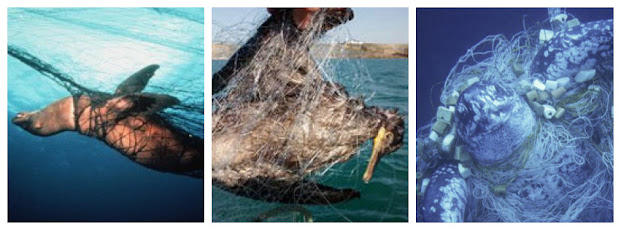Desde a minha chegada à SPEA, o meu interesse por certas temáticas tem aumentado. Um desses temas é o que iriei hoje aqui apresentar muito sucintamente: o “bycatch”, ou em português, captura acidental.
A captura acidental não é mais do que a captura de espécies que não estavam previstas capturar durante a pescaria. Por outras palavras, no ato de pescar, seja de barco em alto mar, ou desde costa, procura-se capturar um género específico de peixe. Por azar, ou não, acabam por ser capturadas outras espécies que não as supostas.
Caso a captura tenha algum valor financeiro e comercial,
esta acaba por ser levada para terra e comercializada. Mas em muitos casos, a
captura acidental composta por peixes, invertebrados, mamíferos, tartarugas
e/ou aves marinhas, sem valor comercial ou proibida, acontece. E a solução
parece simples: arrojar a espécie de volta ao mar, e continuarmos com a nossa vida. Só que não funciona bem assim. Um dos grandes
problemas prende-se no facto de que muitas dessas espécies capturadas
acidentalmente chegam mortas ao convés dos barcos. Por vezes, acabam por ser
capturadas pelas suas guelras, barbatanas, penas ou vêm presas nas redes, e por
não conseguirem chegar à superfície a tempo para respirar, acabam por morrer
lentamente e de forma dolorosa.
Morte bycatch. Imagem: Andrea Marshall
E quando não
chegam mortas, chegam gravemente feridas, com baixas probabilidade de
sobrevivência. Mesmo que se devolva a espécie não alvo ao mar, das duas, uma:
ou ela já está morta, ou irá acabar por morrer em pouco tempo.
Só para termos uma noção da dimensão e da ameaça que
estas espécies e o mundo enfrentam devido à captura acidental, compilei alguns
números que me assustaram pessoalmente:
• 300,000
pequenas baleias e golfinhos;
• 250,000
tartarugas, algumas delas são consideradas criticamente em perigo: as
tartarugas de couro (Dermochelys coriacea);
• 300,000 aves marinhas, incluindo 17 espécies de albatroz (a publicação Bycatch expõe algumas das aves mais capturadas);
• Por 1
quilo de camarão, podem ser encontrados nas redes 5 a 20 quilos de captura
acidental (este número assustou-me, muito devido ao meu amor ao camarão).
 |
| Capturas acidentais por Redes. Fonte das imagens: motherjones.com; medavespesca.pt;wwf-Portugal |
No total, 38 milhões de toneladas de espécies marinhas são capturadas acidentalmente, podendo se traduzir em cerca de 40% do que é pescado mundialmente.
Como já mencionado, nestas capturas existe uma quantidade significativa de espécies descartadas de volta ao mar como lixo, mortas, moribundas ou gravemente feridas. A pesca não seletiva está a colocar o habitat marinho em risco. Sem mencionar o horror que é tratar animais vivos como se de resíduos se tratassem. |
| Captura por anzol. Fonte da imagem:rspb.org.uk |
Porém não tem que ser assim. Existem muitos métodos testados que tornam a pesca mais inteligente, e dessa forma, reduzem as capturas acidentais. Falarei destas medidas de mitigação numa próxima publicação. Até a próxima!
Bycatch (I)
Since my arrival at SPEA, my interest in certain themes has increased. One of these themes is the one that I will present here today, very briefly: the "bycatch".
Bycatch is nothing more than the capture of species that were not intended to
be caught during the fishery. In other words, in the act of fishing, whether
from a boat on the high seas or from the coast, one tries to catch a specific
genus of fish. By bad luck, or not, other species end up being caught.
If the catch has some financial or commercial value, it is taken to land and
sold. But in many cases, the accidental capture of fish, invertebrates,
mammals, turtles, and/or sea birds, without commercial value or prohibited,
happens. And the solution seems simple: throw the species back into the sea,
and get on with our lives. But it doesn't quite work like that. One of the big
problems is that many of these accidentally caught species arrive dead on the
deck of the boat. Sometimes they get caught by their gills, fins, feathers, or
get caught in the nets, and because they can't surface in time to breathe, they
die a slow and painful death.
 |
| Death bycatch. Image: Andrea Marshall |
Just to give you a sense of the scale and threat these species and the world
face from incidental capture, I have compiled some figures that have scared me
personally:
- 300,000 small whales and dolphins;
- 250,000 turtles, some of which are considered critically endangered: leatherback turtles (Dermochelys coriacea);
- 300,000 seabirds, including 17 species of albatross (the Bycatch publication
lists some of the most commonly caught birds);
- For 1 kilo of shrimp, 5 to 20 kilos of incidental catch can be found in nets
(this figure scared me, much due to my love of shrimp).
 |
| Catches by nets. Source of images: motherjones.com; medavespesca.pt; wwf-Portugal |
In total, 38 million tonnes of marine species are caught accidentally, which can translate into about 40% of what is fished globally.
As mentioned earlier, in these catches there is a significant amount of species
discarded back into the sea as litter, dead, dying, or seriously injured.
Non-selective fishing is putting the marine habitat at risk. Not to mention the
horror of treating live animals as if they were waste.
 |
| Catch by hook. Source of the picture: rspb.org.uk |
But it doesn't have to be this way. There are many tested
methods that make fishing smarter and thereby reduce bycatch. I will talk about
these mitigation measures in a future post. Until next time!


Sem comentários:
Enviar um comentário